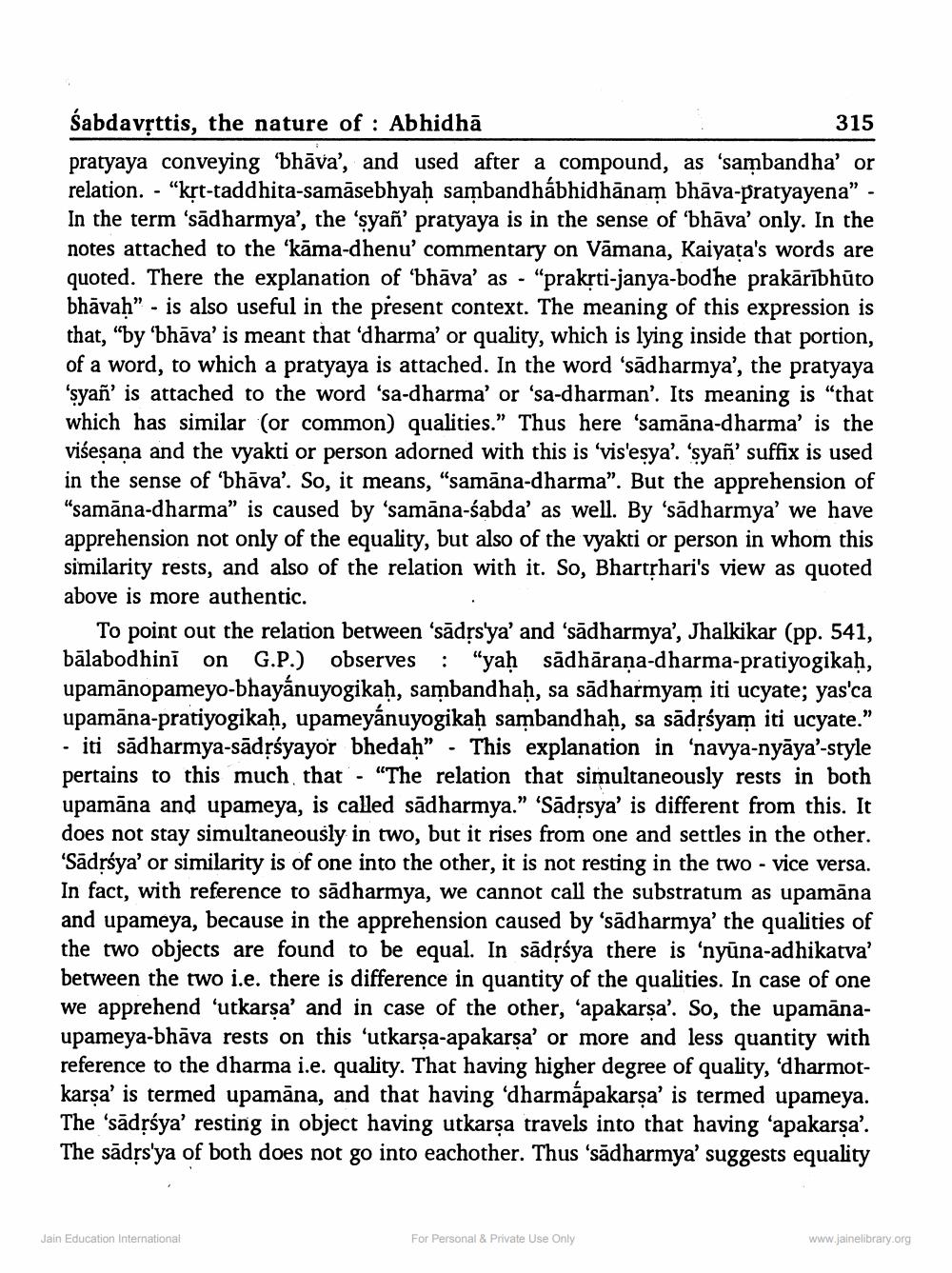________________
Sabdavṛttis, the nature of Abhidha
315
-
pratyaya conveying 'bhāva', and used after a compound, as 'sambandha' or relation. - “kṛt-taddhita-samāsebhyaḥ sambandhábhidhānam bhāva-pratyayena" - In the term 'sādharmya', the 'ṣyañ' pratyaya is in the sense of 'bhāva' only. In the notes attached to the 'kama-dhenu' commentary on Vamana, Kaiyata's words are quoted. There the explanation of 'bhāva' as - "prakṛti-janya-bodhe prakārībhūto bhavaḥ" is also useful in the present context. The meaning of this expression is that, "by 'bhāva' is meant that 'dharma' or quality, which is lying inside that portion, of a word, to which a pratyaya is attached. In the word 'sādharmya', the pratyaya 'syan' is attached to the word 'sa-dharma' or 'sa-dharman'. Its meaning is "that which has similar (or common) qualities." Thus here 'samana-dharma' is the viśeṣaṇa and the vyakti or person adorned with this is 'vis'esya'. 'syañ' suffix is used in the sense of 'bhāva'. So, it means, “samāna-dharma". But the apprehension of "samana-dharma" is caused by 'samana-śabda' as well. By 'sadharmya' we have apprehension not only of the equality, but also of the vyakti or person in whom this similarity rests, and also of the relation with it. So, Bhartṛhari's view as quoted above is more authentic.
To point out the relation between 'sādṛs'ya' and 'sādharmya', Jhalkikar (pp. 541, bālabodhini on G.P.) observes : "yaḥ sadhāraṇa-dharma-pratiyogikaḥ, upamānopameyo-bhayánuyogikaḥ, sambandhaḥ, sa sad harmyam iti ucyate; yas'ca upamana-pratiyogikaḥ, upameyánuyogikaḥ sambandhaḥ, sa sādṛśyam iti ucyate." - iti sādharmya-sādṛśyayor bhedaḥ" - This explanation in 'navya-nyāya'-style pertains to this much that "The relation that simultaneously rests in both upamāna and upameya, is called sadharmya." "Sādṛsya' is different from this. It does not stay simultaneously in two, but it rises from one and settles in the other. 'Sadṛśya' or similarity is of one into the other, it is not resting in the two - vice versa. In fact, with reference to sadharmya, we cannot call the substratum as upamāna and upameya, because in the apprehension caused by 'sādharmya' the qualities of the two objects are found to be equal. In sādṛśya there is 'nyūna-adhikatva' between the two i.e. there is difference in quantity of the qualities. In case of one we apprehend 'utkarṣa' and in case of the other, 'apakarṣa'. So, the upamanaupameya-bhāva rests on this 'utkarṣa-apakarṣa' or more and less quantity with reference to the dharma i.e. quality. That having higher degree of quality, 'dharmotkarṣa' is termed upamana, and that having 'dharmapakarṣa' is termed upameya. The 'sādṛśya' resting in object having utkarṣa travels into that having 'apakarṣa'. The sadṛs'ya of both does not go into eachother. Thus 'sādharmya' suggests equality
Jain Education International
For Personal & Private Use Only
www.jainelibrary.org




